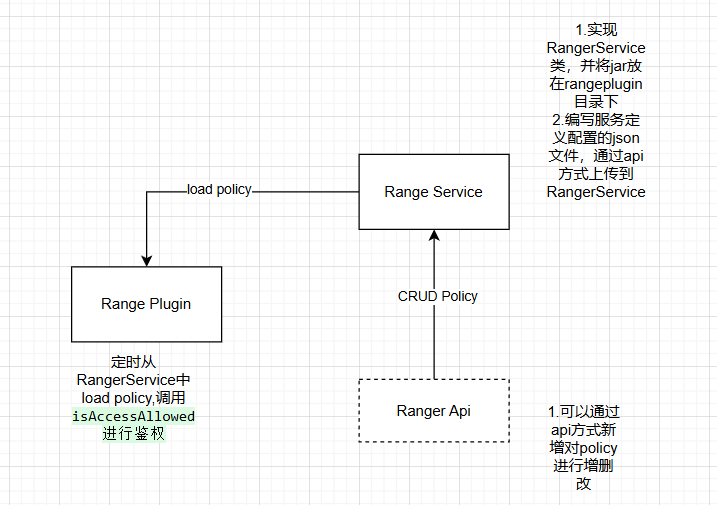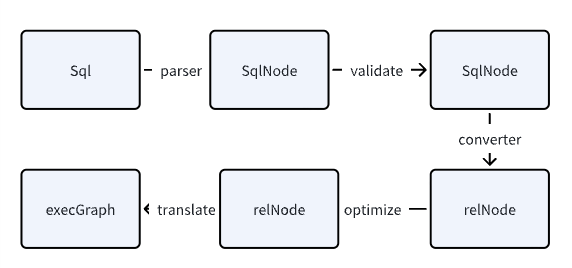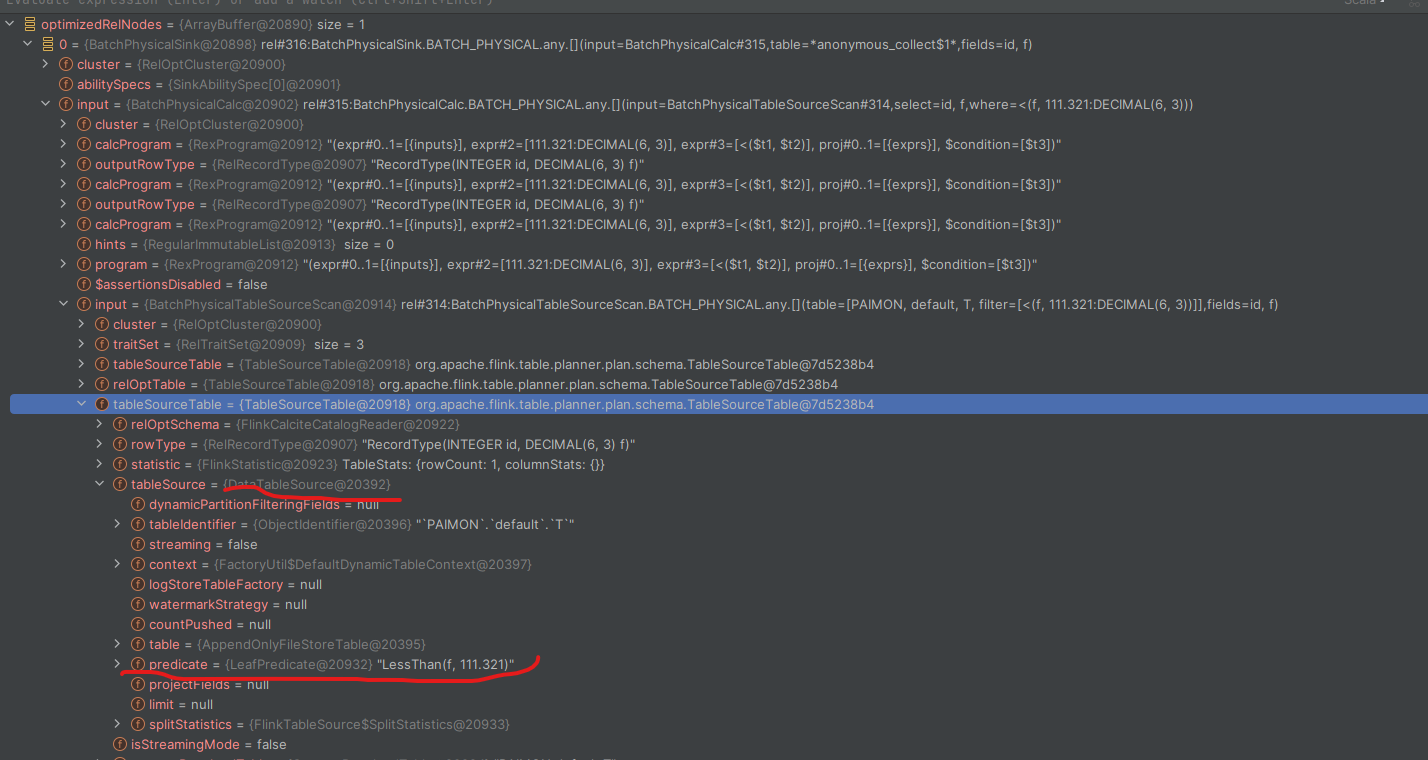Ranger Paimon插件
简介
Apache Ranger为Hadoop体系提供了同意的安全体系,包括访问权限控制和统一的审计(记录谁访问Ranger进行权限设置或者校验等操作)。如果想要开发一个Ranger的插件主要三个部分:
Ranger服务端:需要定义一个服务类型JSON文件上传给Ranger Service,以及实现一个RangerBaseService类作为Ranger服务的资源查找,或者配置检验的jar包放到Ranger服务的range-plugins/
Ranger鉴权的插件:根据Ranger提供的接口实现一个鉴权的插件,这个插件会定时从Ranger-Service端将权限同步到本地,需要鉴权的服务可以用对应的接口来进行权限校验。很多服务例如doris,hive是将这个插件集成到了他们的服务中,当然也可以拿出来单独使用,例如自己解析Sql语句拿到用户以及对应表时在调用插件接口进行鉴权。
Ranger授权api:这一部分可以通过Ranger提供的UI手动进行添加,ranger也提供了api,用户可以通过api进行新增权限,或者删除更改权限等。权限这块Ranger内称之为RangerPolicy策略。
Ranger服务端
实现RangerBaseService类
public class RangerServicePaimon extends RangerBaseService {
@Override
public Map<String, Object> validateConfig() {
return new HashMap<>();
}
@Override
public List<String> lookupResource(ResourceLookupContext resourceLookupContext) throws Exception {
return new ArrayList<>();
}
}此类有两个方法,都是用于在Ranger Service UI上做资源查询,或者配置检验时用的,可以不做实现,直接返回空也没问题。之后需要将实现的jar包放入range-plugins/
服务定义描述文件
{
"name": "paimon",
"displayName": "Paimon",
//对应jar包的service实现类
"implClass": "com.jiduauto.ranger.service.paimon.RangerServicePaimon",
"label": "Paimon",
"description": "Paimon",
//需要进行权限检验的资源
"resources": [
{
"itemId": 1,
"name": "catalog",
"type": "string",
"level": 10,
"parent": "",
"mandatory": true,
"isValidLeaf": true,
"lookupSupported": true,
"recursiveSupported": false,
"excludesSupported": true,
"matcher": "org.apache.ranger.plugin.resourcematcher.RangerDefaultResourceMatcher",
"matcherOptions": {
"wildCard": true,
"ignoreCase": true
},
"validationRegEx": "",
"validationMessage": "",
"uiHint": "",
"accessTypeRestrictions": [
"create",
"show",
"alter",
"drop"
],
"label": "Paimon Catalog",
"description": "Paimon Catalog"
},
{
"itemId": 2,
"name": "database",
"type": "string",
"level": 20,
"parent": "catalog",
"mandatory": true,
"isValidLeaf": true,
"lookupSupported": true,
"recursiveSupported": false,
"excludesSupported": true,
"matcher": "org.apache.ranger.plugin.resourcematcher.RangerDefaultResourceMatcher",
"matcherOptions": {
"wildCard": true,
"ignoreCase": true
},
"validationRegEx": "",
"validationMessage": "",
"uiHint": "",
"accessTypeRestrictions": [
"create",
"show",
"alter",
"drop"
],
"label": "Paimon Database",
"description": "Paimon Database"
},
{
"itemId": 3,
"name": "table",
"type": "string",
"level": 30,
"parent": "database",
"mandatory": true,
"isValidLeaf": true,
"lookupSupported": true,
"recursiveSupported": false,
"excludesSupported": true,
"matcher": "org.apache.ranger.plugin.resourcematcher.RangerDefaultResourceMatcher",
"matcherOptions": {
"wildCard": true,
"ignoreCase": true
},
"validationRegEx": "",
"validationMessage": "",
"uiHint": "",
"accessTypeRestrictions": [
"create",
"show",
"alter",
"drop",
"insert",
"select"
],
"label": "Paimon Table",
"description": "Paimon Table"
},
{
"itemId": 4,
"name": "column",
"type": "string",
"level": 40,
"parent": "table",
"mandatory": true,
"lookupSupported": true,
"recursiveSupported": false,
"excludesSupported": true,
"matcher": "org.apache.ranger.plugin.resourcematcher.RangerDefaultResourceMatcher",
"matcherOptions": {
"wildCard": true,
"ignoreCase": true
},
"validationRegEx": "",
"validationMessage": "",
"uiHint": "",
"accessTypeRestrictions": [
"select"
],
"label": "Paimon Column",
"description": "Paimon Column"
}
],//需要进行校验的访问类型
"accessTypes": [
{
"itemId": 1,
"name": "show",
"label": "Show"
},
{
"itemId": 2,
"name": "insert",
"label": "Insert"
},
{
"itemId": 3,
"name": "alter",
"label": "Alter"
},
{
"itemId": 4,
"name": "create",
"label": "Create"
},
{
"itemId": 5,
"name": "drop",
"label": "Drop"
},
{
"itemId": 6,
"name": "select",
"label": "Select"
},
{
"itemId": 7,
"name": "all",
"label": "All",
"impliedGrants":
[
"select",
"insert",
"create",
"drop",
"alter",
"show"
]
}
],
// ranger serviceUI上需要填写的配置,RangerBaseService的validateConfig方法就是对这些配置进行校验
"configs": [
{
"itemId": 1,
"name": "username",
"type": "string",
"mandatory": true,
"validationRegEx": "",
"validationMessage": "",
"uiHint": "",
"label": "Username"
},
{
"itemId": 2,
"name": "password",
"type": "password",
"mandatory": false,
"validationRegEx": "",
"validationMessage": "",
"uiHint": "",
"label": "Password"
},
{
"itemId": 3,
"name": "jdbc.driver_class",
"type": "string",
"mandatory": true,
"validationRegEx": "",
"validationMessage": "",
"uiHint": "",
"defaultValue": "com.mysql.cj.jdbc.Driver"
},
{
"itemId": 4,
"name": "jdbc.url",
"type": "string",
"mandatory": true,
"defaultValue": "",
"validationRegEx": "",
"validationMessage": "",
"uiHint": ""
}
],
"enums": [
],
"contextEnrichers": [
],
"policyConditions":
[
],//对数据某些字段进行脱敏使用
"dataMaskDef": {
"accessTypes": [
{
"name": "select"
}
],
"resources": [
{
"name": "catalog",
"matcherOptions": {
"wildCard": "true"
},
"lookupSupported": true,
"uiHint":"{ \"singleValue\":true }"
},
{
"name": "database",
"matcherOptions": {
"wildCard": "true"
},
"lookupSupported": true,
"uiHint":"{ \"singleValue\":true }"
},
{
"name": "table",
"matcherOptions": {
"wildCard": "true"
},
"lookupSupported": true,
"uiHint":"{ \"singleValue\":true }"
},
{
"name": "column",
"matcherOptions": {
"wildCard": "true"
},
"lookupSupported": true,
"uiHint":"{ \"singleValue\":true }"
}
],//脱敏的函数
"maskTypes": [
{
"itemId": 1,
"name": "MASK",
"label": "Redact",
"description": "Replace lowercase with 'x', uppercase with 'X', digits with '0'",
"transformer": "mask({col})",
"dataMaskOptions": {
}
},
{
"itemId": 2,
"name": "MASK_SHOW_LAST_4",
"label": "Partial mask: show last 4",
"description": "Show last 4 characters; replace rest with 'x'",
"transformer": "mask_show_last_n({col}, 4, 'x', 'x', 'x', -1, '1')"
},
{
"itemId": 3,
"name": "MASK_SHOW_FIRST_4",
"label": "Partial mask: show first 4",
"description": "Show first 4 characters; replace rest with 'x'",
"transformer": "mask_show_first_n({col}, 4, 'x', 'x', 'x', -1, '1')"
},
{
"itemId": 4,
"name": "MASK_HASH",
"label": "Hash",
"description": "Hash the value",
"transformer": "mask_hash({col})"
},
{
"itemId": 5,
"name": "MASK_NULL",
"label": "Nullify",
"description": "Replace with NULL"
},
{
"itemId": 6,
"name": "MASK_NONE",
"label": "Unmasked (retain original value)",
"description": "No masking"
},
{
"itemId": 12,
"name": "MASK_DATE_SHOW_YEAR",
"label": "Date: show only year",
"description": "Date: show only year",
"transformer": "mask({col}, 'x', 'x', 'x', -1, '1', 1, 0, -1)"
},
{
"itemId": 13,
"name": "CUSTOM",
"label": "Custom",
"description": "Custom"
}
]
},//对数据行级过滤
"rowFilterDef": {
"accessTypes": [
{
"name": "select"
}
],
"resources": [
{
"name": "catalog",
"matcherOptions": {
"wildCard": "true"
},
"lookupSupported": true,
"mandatory": true,
"uiHint": "{ \"singleValue\":true }"
},
{
"name": "database",
"matcherOptions": {
"wildCard": "true"
},
"lookupSupported": true,
"mandatory": true,
"uiHint": "{ \"singleValue\":true }"
},
{
"name": "table",
"matcherOptions": {
"wildCard": "true"
},
"lookupSupported": true,
"mandatory": true,
"uiHint": "{ \"singleValue\":true }"
}
]
}
}说白了就是定义一些资源,以及对这些资源进行校验的访问类型。例如table资源支持的访问类型是"create","show", "alter","drop","insert","select"。
这里简单说一下dataMaskDef,例如用户查询时想对某些字段进行脱密,他的查询sql是:SELECT NAME,PHONE FROM USER;对phone字段想做脱敏的话可以将查询修改为:SELECT NAME,CAST(mask(PHONE) AS STRING) FROM USER。实现这个功能就需要平台侧拿到sql之后对sql进行解析得到表的字段,之后访问Ranger判断这个字段需不需要进行datamask,需要的或就将其转换成对应的函数。
https://juejin.cn/post/7231858374827933753这篇文章讲的更细致一些,可以参考。
注意:range只是用做记录哪些表的字段需要做datamask,具体解析sql之类的需要平台自己去做,可以将Ranger当做一个记录了权限相关信息的数据库来看。
Ranger Plugin
rangerPlugin会定时从service load相关policy到本地做鉴权。需要定义三个xml文件。需要将以下三个文件放在resources文件下,或者放在java启动时classpath下:
ranger-paimon-dev-audit.xml
<?xml version="1.0" encoding="UTF-8"?>
<?xml-stylesheet type="text/xsl" href="configuration.xsl"?>
<configuration>
</configuration>
ranger-paimon-dev-policymgr-ssl.xml
<?xml version="1.0"?>
<?xml-stylesheet type="text/xsl" href="configuration.xsl"?>
<configuration xmlns:xi="http://www.w3.org/2001/XInclude">
<!-- The following properties are used for 2-way SSL client server validation -->
<property>
<name>xasecure.policymgr.clientssl.keystore</name>
<value>hadoopdev-clientcert.jks</value>
<description>
Java Keystore files
</description>
</property>
<property>
<name>xasecure.policymgr.clientssl.truststore</name>
<value>cacerts-xasecure.jks</value>
<description>
java truststore file
</description>
</property>
<!--路径自己指定一个-->
<property>
<name>xasecure.policymgr.clientssl.keystore.credential.file</name>
<value>jceks://file/User/xxxx/work/keystore-hadoopdev-ssl.jceks</value>
</property>
<!--路径自己指定一个-->
<property>
<name>xasecure.policymgr.clientssl.truststore.credential.file</name>
<value>jceks://file/User/xxx/work/truststore-hadoopdev-ssl.jceks</value>
</property>
</configuration>
ranger-paimon-dev-security.xml
<?xml version="1.0"?>
<?xml-stylesheet type="text/xsl" href="configuration.xsl"?>
<configuration xmlns:xi="http://www.w3.org/2001/XInclude">
<!--此处填写测试环境创建的ranger service name-->
<property>
<name>ranger.plugin.paimon-dev.service.name</name>
<value>paimonrt</value>
</property>
<property>
<name>ranger.plugin.paimon-dev.policy.source.impl</name>
<value>org.apache.ranger.admin.client.RangerAdminRESTClient</value>
</property>
<!--此处填写测试环境的ranger admin url 不要写ip 如果有kerberos认证-->
<property>
<name>ranger.plugin.paimon-dev.policy.rest.url</name>
<value>xxxxxx</value>
</property>
<property>
<name>ranger.plugin.paimon-dev.policy.pollIntervalMs</name>
<value>30000</value>
<description>
How often to poll for changes in policies?
</description>
</property>
<property>
<name>ranger.plugin.paimon-dev.policy.rest.ssl.config.file</name>
<value>ranger-paimon-policymgr-ssl.xml</value>
<description>
Path to the file containing SSL details to contact Ranger Admin
</description>
</property>
<!--cache路径自己指定一个-->
<property>
<name>ranger.plugin.paimon-dev.policy.cache.dir</name>
<value>/Users/xxxx/work/cache</value>
<description>
Directory where Ranger policies are cached after successful retrieval from the source
</description>
</property>
</configuration>
实现Plugin以及做验证,此处checkPermission()方法更详细的实现可以看,贴出的代码只是做个示例。
https://github.com/apache/ranger/compare/master...herefree:ranger:support-paimon-ranger
public class RangerPaimonPlugin extends RangerBasePlugin {
public RangerPaimonPlugin(String serviceType) {
super(serviceType, null, null);
super.init();
}
public RangerPaimonPlugin(String serviceType, String serviceName) {
super(serviceType, serviceName, null);
super.init();
}
}
public boolean checkPermission(AccessType accessType, PrivilegedEntity entity, UserGroupInformation ugi) {
RangerPaimonPlugin plugin = new RangerPaimonPlugin('xxxx');
RangerAccessRequestImpl request = new RangerAccessRequestImpl();
RangerResourceImpl resource = new RangerResourceImpl();
resource.setValue("queue", entity.getName());
request.setResource(resource);
request.setAccessType(getRangerAccessType(accessType));
request.setUser(ugi.getShortUserName());
request.setUserGroups(Sets.newHashSet(ugi.getGroupNames()));
request.setAccessTime(new Date());
request.setClientIPAddress(getRemoteIp());
RangerAccessResult result = plugin.isAccessAllowed(request);
return result == null ? false : result.getIsAllowed();
}Ranger Api
用户可以使用Api方式来对policy进行增删改查,当前也可以在rangerServiceUI上进行操作,这里记录下如何使用api方式创建policy。ranger官方api文档https://cwiki.apache.org/confluence/display/RANGER/Ranger+Client+Libraries
public class PaimonPolicyManager {
private RangerClient rangerClient;
private String policyName;
private String RANGER_SERVICE_NAME;
public void createPolicy() {
//先通过api查找是否存在对应的policy
Map<String, String> filter = new HashMap<>();
filter.put("policyName", policyName);
filter.put("serviceName", RANGER_SERVICE_NAME);
List<RangerPolicy> policies = rangerClient.findPolicies(filter);
if (policies.isEmpty()) {
//不存在就创建新的policy
rangerClient.createPolicy(creatPolicy("group", policyName, "db", "tb", Collections.singletonList("select")));
}else{
//存在的话就更新,在原有的policy上新增一个Policyitem(例如原来有select权限,后面在新增个drop权限)
List<String> updatePermission = new ArrayList<>();
if(checkPolicy(policies.get(0),"group","select")) {
RangerPolicy rangerPolicy = addPolicyIterm(policies.get(0), "group", Collections.singletonList("select"));
rangerClient.updatePolicy(RANGER_SERVICE_NAME,policyName,rangerPolicy);
}
}
}
public boolean checkPolicy(RangerPolicy rangerPolicy, String group, String permissionOp) {
for (RangerPolicy.RangerPolicyItem policyItem : rangerPolicy.getPolicyItems()) {
List<String> groups = policyItem.getGroups();
if (!groups.contains(group)) {
continue;
}
for (RangerPolicy.RangerPolicyItemAccess access : policyItem.getAccesses()) {
if (access.getType().equals(permissionOp)) {
return true;
}
}
}
return false;
}
public RangerPolicy createPolicy(String group, String policyName, String dbname, String tbName, List<String> permissionOpsList) {
RangerPolicy rangerPolicy = new RangerPolicy();
rangerPolicy.setService(RANGER_SERVICE_NAME);
rangerPolicy.setName(policyName);
rangerPolicy.setResources(creatResource(dbname,tbName));
List<RangerPolicy.RangerPolicyItem> rangerPolicyItemList = new ArrayList<>();
for(String op:permissionOpsList) {
RangerPolicy.RangerPolicyItem rangerPolicyItem = creatRangerPolicyItem(group, op);
rangerPolicyItemList.add(rangerPolicyItem);
}
rangerPolicy.setPolicyItems(rangerPolicyItemList);
return rangerPolicy;
}
public static Map<String, RangerPolicy.RangerPolicyResource> createResource(String dbName, String tbName) {
Map<String, RangerPolicy.RangerPolicyResource> resourceMap = new HashMap<>();
resourceMap.put("catalog", new RangerPolicy.RangerPolicyResource("paimon"));
resourceMap.put("database", new RangerPolicy.RangerPolicyResource(dbName));
resourceMap.put("table", new RangerPolicy.RangerPolicyResource(tbName));
return resourceMap;
}
public RangerPolicy.RangerPolicyItem createRangerPolicyItem(String group, String permission) {
RangerPolicy.RangerPolicyItem rangerPolicyItem = new RangerPolicy.RangerPolicyItem();
rangerPolicyItem.setGroups(Collections.singletonList(group));
RangerPolicy.RangerPolicyItemAccess rangerPolicyItemAccess = new RangerPolicy.RangerPolicyItemAccess();
rangerPolicyItemAccess.setType(permission);
rangerPolicyItemAccess.setIsAllowed(true);
rangerPolicyItem.setAccesses(Collections.singletonList(rangerPolicyItemAccess));
return rangerPolicyItem;
}
private RangerPolicy addPolicyIterm(RangerPolicy rangerPolicy, String group, List<String> permissionOpList) {
List<RangerPolicy.RangerPolicyItem> addRangerPolicyItemList = new ArrayList<>();
for (String permissionOp : permissionOpList) {
addRangerPolicyItemList.add(createRangerPolicyItem(group, permissionOp));
}
List<RangerPolicy.RangerPolicyItem> policyItems = rangerPolicy.getPolicyItems();
policyItems.addAll(addRangerPolicyItemList);
return rangerPolicy;
}
}
